Introduction to Primavera P6 Steps
Primavera P6 offers a unique feature that allows the user to break down activities into smaller components to track the completion of tasks in the project schedule. The smaller components are known as steps, and several steps can make up the total completion of a single task. There is no requirement for the number of steps to be defined for each task, as each scheduled task may contain varying numbers of individual steps.
Each Primavera P6 step is predefined and weighted by a percentage of the total of the task. Weighted steps track the progress of the activity through the completion of each step based on the weight of the step. Primavera P6 steps can also be created within step templates, which in turn can be assigned to other tasks in the project schedule. This article addresses how to use the Primavera P6 steps feature in Primavera P6 project schedules.
Setting Up Primavera P6 for the Utilization of the Steps Feature
Implementing the correct settings in Primavera P6 is essential before using the steps feature. First, select your project from the Primavera P6 main projects menu and go to the Calculations tab. Check the box next to “Activity percent complete based on activity steps”:

With the project open, go to the General tab of the Primavera P6 bottom activities menu. Each activity that will employ the steps feature will need to be set to a percent complete type of “physical”. Also, ensure that the Activity Type is “Resource Dependent” and that the Duration Type is set to “Fixed Duration & Units”:

Next, go to the bottom activities menu to see if you have the “Steps” tab visible. If it is not visible, right-click in the area where you have the Steps tab selected. Choose “Customize Activity Details…”:

In the Activity Details dialog box, select “Steps” from the Available Tabs section and use the arrow key in the center to move this selection to the Display Tabs section. Select “Apply” and then “OK”:
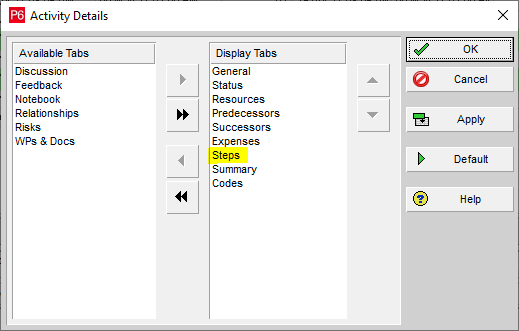
Next, right-click in the bottom layout and select “Customize Steps Columns…”:
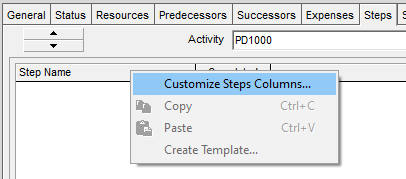
In the Steps Columns dialog box, select Step % Complete, Step Weight, and Step Weight Percent under the General heading in the Available Options. Use the center double arrow key to move these selections at one time to the Selected Options section of the dialog box, and then click “OK”:
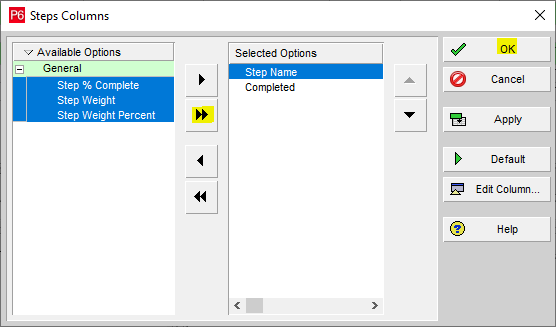
Adding Primavera P6 Steps to the Project Schedule
To add steps to a Primavera P6 activity, highlight the activity of interest and go to the Steps tab at the bottom of the Primavera P6 activities menu and select “Add”:
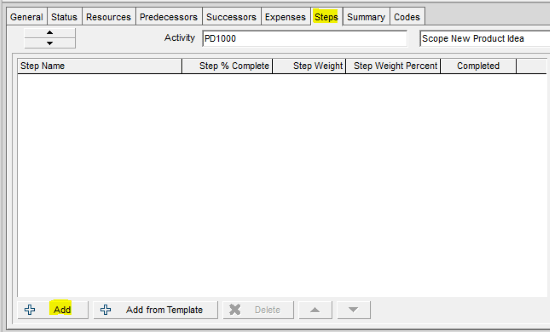
Next, a highlighted line will appear for you to customize and define the step’s name, weight, and weight percent of the overall task. Continue to use this same method to add additional steps to the activity. If a step needs to be deleted, use the “Delete” button to remove the unwanted step:
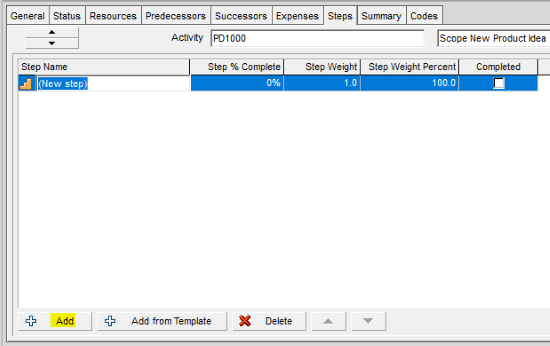
Creating and Adding Primavera P6 Steps from a Template
Primavera P6 allows the user to develop step templates that can be used across multiple projects. This efficiency allows organizations to maintain consistency among similar projects when needed.
Creating a step template is simple in Primavera P6. Go to the Steps tab in the bottom activity menu in Primavera P6 and select the button, “Add”:
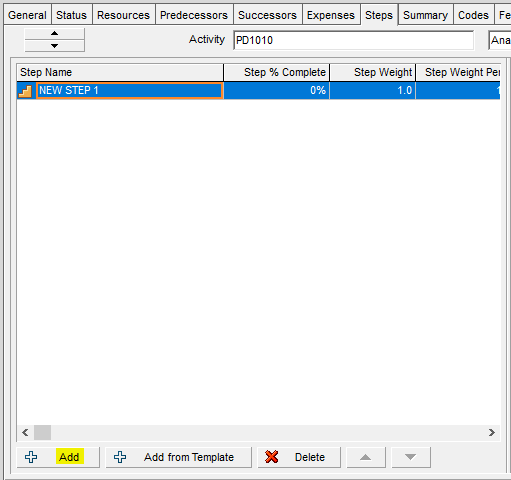
You will then name your step and assign the weight percentage. Repeat this step until you have created all of the steps that you want to save to a template. Next, right-click on one of the steps and select “Create Template…”:

You now have the option to name your step template for future use. Click “OK” to save the step template:

To assign an existing step template in Primavera P6, go to the Steps tab in the bottom activity menu in Primavera P6 and select the button, “Add from Template”:

The step template will be added to your current task. Although you cannot modify the step template’s original name, you can modify the steps within the template by clicking within them to change the name. Further, you can use the “Modify” button to add or alter any notes associated with a step:

Taking Progress on Primavera P6 Steps in the Project Schedule
Progress can be taken quickly when using the Primavera P6 steps feature. Each step is predefined, broken out from the total, and properly weighted. Therefore, when it is time to take status, simply update the steps that are complete by putting a checkmark in the box next to the completed step in the “Completed” column in the bottom layout:
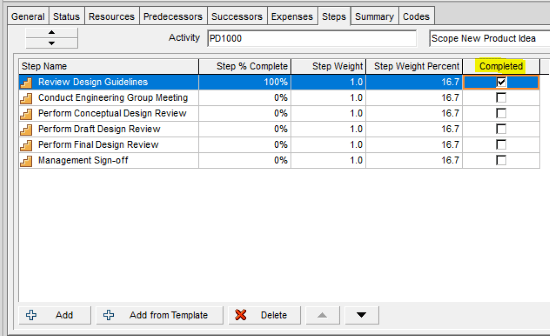
Also, you can take partial credit (for example, 50% complete) on a step. Many project managers and project schedulers/planners prefer to take credit on steps only at the completion level since the steps are often broken down into smaller increments that do not require partial completion credit.
When updating progress, you will progress Primavera P6 in the same manner that you normally do. Always assign an actual start to the activity itself, and in this example, we will use expected finish dates:

Once all of the progress has been input into the schedule and accomplished, schedule your project with the current data date:
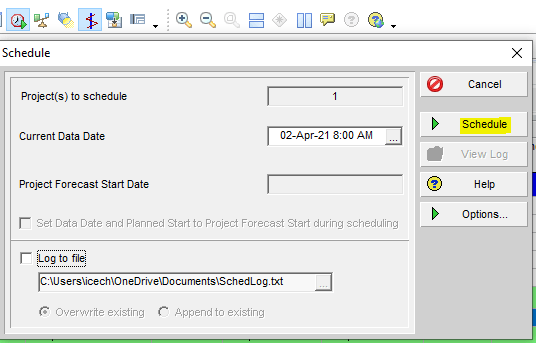
The example below shows a before and after screenshot of the task in the schedule utilizing the steps feature. The first screenshot is the task before being progressed, and the second screenshot is the result of marking one of the steps complete and scheduling the project with the current data date. Take notice that the physical percent complete automatically updated based on the completion of one of the steps:


Conclusion
Primavera P6 allows users to have flexibility in how they set up their project schedules by allowing the schedule to contain granular detail without forcing the user to include this detail at the task level. Steps are predefined and weighted appropriately while not impacting the schedule at a very fine level of detail where the project team may not benefit from such a great level of detail.
Contact Consult Leopard for a construction scheduling consultant now.





